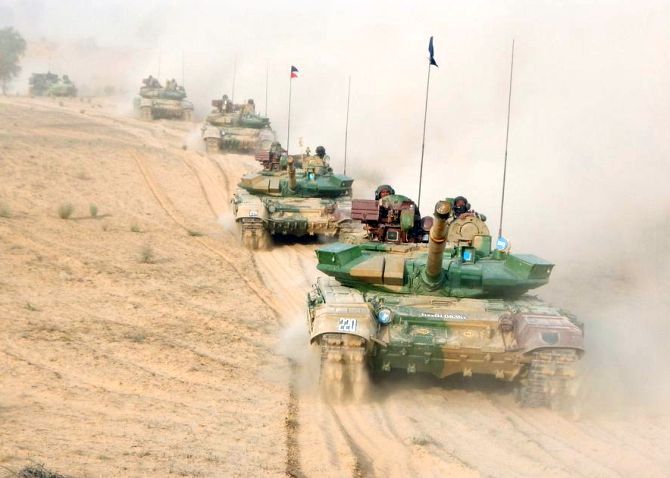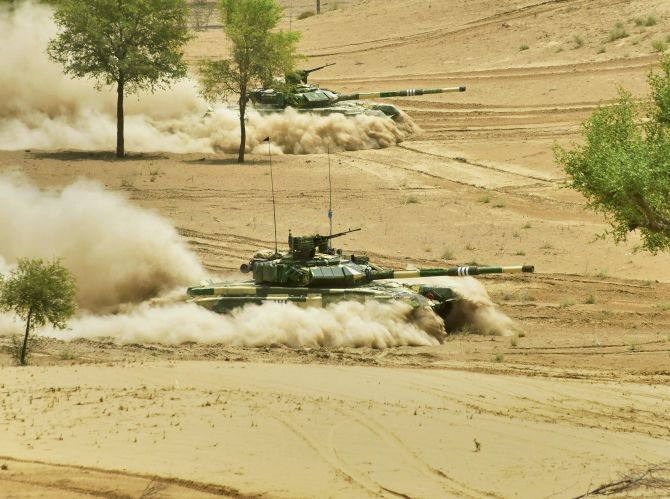'With two nuclear neighbours, how likely is it for our armed forces to battle in a contaminated environment that could include nuclear, biological or chemical attacks by the adversary?'
'Are we prepared for the threat?'
Brigadier S K Chatterji (retd) explains the meaning and significance of Operation Vijay Prahar.

IMAGE: Braving temperatures above 45 degrees Celsius and sand storms, troops from the Indian Army's Jaipur-based South Western Command conducted drills to fight in all contingencies including a nuclear weapon environment in Rajasthan's Mahajan field firing ranges during Vijay Prahar, a military exercise which began on May 1 and ended on Wednesday, May 9.
In the scorching heat of the Rajasthan desert, the Indian Army's South Western Command exercised its Strike Corps to race at full gallop to capture/threaten objectives deep inside enemy territory, during the 1st/2nd week of May 2018.
The entire exercise was conducted under a nuclear overhang.
With two nuclear neighbours, how likely is it for our armed forces to battle in a contaminated environment that could include nuclear, biological or chemical attacks by the adversary?
Are we prepared for the threat?
Let's begin with the bigger threat from the lesser adversary -- Pakistan.
The Chinese have a more responsible government. Beijing does not undertake nuclear sabre-rattling every other day.
Pakistan rattles its nuclear sabre when it encounters reverses in the proxy war it has initiated, like, for instance, after the surgical strikes by Indian commandos on terrorist camps stretched across the Line of Control.
Pakistan does not have a nuclear doctrine per se. However its leadership -- both military and political -- make enough statements to define the basic tenets.
The Pakistani approach is almost entirely India centric. The most defining aspect of the Pakistan nuclear doctrine is it does not have a 'No First Use' clause.
Pakistan has carefully omitted a 'No First Use' clause to enhance the deterrence value of its nuclear arsenal by holding onto the option of being the first to press the nuclear button.
However, the conceptual framework of the Pakistani doctrine is not exactly minimum nuclear deterrence. There could have been no requirement for building a stockpile of 110 to 130 nuclear warheads, as estimated, had Pakistan opted for minimum deterrence.
Pakistan's build-up of its nuclear capability has been influenced by the growing asymmetry of its conventional capabilities vis-a-vis India.
It has increased the size of its atomic arsenal and pursued the ability to undertake a second strike over the years.
This has been done even though the Pakistani strategic objective today is apparently not winning a war against India, but deterring aggression and denying India a major military victory.
What continues to haunt the Pakistani psyche is the dismemberment of the erstwhile East Pakistan, now Bangladesh, in 1971.
Beyond the Indian conventional build-up, Pakistan has been more than concerned with India's Cold Start doctrine that if successfully executed could result in multiple armour thrusts into its areas.
The Indian focus on ballistic missile defence capabilities also has Pakistan worried.
Even if Pakistan were to initiate a nuclear exchange, the Indian capability to negate Pakistan's first strike provides India with a rationale to employ its nuclear arsenal.
Pakistan's inability to penetrate the Indian ballistic missile defence shield will leave Indian resources intact to undertake such a task.
Pakistan has hence gone in for a large variety of delivery means.
The Babur land attack Cruise missile has a range of 750 km. The Ra’ad air delivered cruise missile has a range of 350 km.
Pakistan has also gone in for the Hatf IX (Nasr) SRBM. Pakistan also has the 2,750 km Shaheen III missile.
Pakistan is also focused on developing multiple re-entry warheads to beat the Indian ballistic missile defence shield.
The Nasr is primarily designed to strike the armoured pincers the Indian Cold Start philosophy contemplates.
In such an eventuality, as these pincers maneuver forward into Pakistan and achieve success both in their breadth and depth of penetration within Pakistani territory, the spearheads of these pincers, or bottlenecks along their approaches could be targeted.
Such attacks launched within Pakistani territory could raise the issue of legitimacy of an Indian nuclear response in their areas.
These attacks, categorised as counter-force targeting, also entail difficulties in delegation of authority to operational commanders to use a weapon system that has huge strategic ramifications.
For the Indians, it would involve either stopping in their tracks or follow up elements bypassing the contaminated area to further depths with the attendant risk of facing follow on attacks.
The Pakistanis will also need to carry out multiple attacks on successful Indian thrusts which will require co-ordination at the strategic level, real time situational awareness, a fully networked environment with the national command centre being able to conduct target analysis and selection.
Notwithstanding these options, the shock and awe effects could be enough to stop the Indian advance and look for other alternatives, including the exercise of a nuclear option.

IMAGE: The Indian Army is confident of continuing its offensive even after a tactical nuclear, chemical or biological attack by the adversary, South Western Army Commander Lieutenant General Cherish Mathson said after Operation Vijay Prahar ended.
When the impact of such strikes by Pakistan are analysed, the effect of the use of tactical nuclear weapons is really quite minimal, given the dispersion of combat elements that the Indian forces would practice with the nuclear overhang being there.
Further, the Indians will protect their troops and equipment with necessary measures to include both clothing and hardening of equipment to minimise casualties.
The international furore that would follow would also disallow the Pakistani ruling elite, including its military leadership, to continue in power.
All told, Pakistan's exercise of its nuclear option at any stage does not hold any dividends for its ruling elite; in effect, it would be their demise for certain.
If the nuclear threat from our northern neighbour is evaluated, it is far lower on the scales.
China has the conventional capability to blunt Indian counter-offensives in Tibet. Our capabilities allow us a successful defensive stance with limited success to either side, sectorally.
The raising of a strike corps by the Indians, or rewiring additional strike resources meant for the plains for operations in the mountains, does not create an overwhelming strategic imbalance in our favour in the mountains.
In the mountains, using nuclear, biological and chemical weapons is also more difficult, with weather conditions being more unpredictable, crest lines in the vicinity and tunneling effects along the valleys.
Ionising radiation can be stopped by ridge lines and thermal radiation will be similarly affected. However, blast effects could be channelised through valleys and be even reflected back by nearby crest lines.
The Indian armed forces have been enhancing their capabilities at fighting in an NBC (nuclear, biological or chemical) environment for decades now.
The preparations have involved developing of operational concepts, practicing these in various exercises, and procurement of equipment that enhances survivability of both man and machine while operating in an NBC environment.
The Indians are also well on their way to survive a first strike with a triad capability involving launch of attacks from land, air and under-sea platforms.
In terms of ballistic missile reach, India's Agni 5 gives it a range of 5,000 km which makes the entire Chinese mainland vulnerable. The Chinese nuclear capability is much higher. However, its focus is not India, but the American and European continents.
The other threat that emerges from Pakistan is the feasibility of NBC weapons being used without proper authorisation.
Post a point when Indian armed forces would have penetrated into Pakistan, Islamabad will have ordered mobilisation and deployment of its NBC assets.
In peace time the warheads are stored with their parts in different areas. However, the warheads would be mated with delivery means and made ready for use during operations.
It is a fact that a substantial percentage of Pakistani army officers are radicalised. The possibility of someone with the necessary access playing truant has to be a part of the Indian calculus.
The issue of jihadis getting hold of Pakistan's NBC arsenal is also an area of grave concern, and an issue by itself.
For the Pakistanis to be bleeding their exchequer for further accumulation of nuclear warheads and missile systems is hardly a sensible approach.
Not adopting a 'No First Use' policy, along with minimum nuclear deterrence, is adequate wherewithal.
India would have to factor in the probability of crossing the Pakistani threshold if it decides that its armoured pincers strike deep in that country.
However, the Pakistani leadership, including its military top brass, would lose their hold on the country by using nuclear weapons.
The global response would be to immediately change the regime on account of its extreme immaturity. It is an aspect that surely the Pakistani military and political leadership understands clearly.










